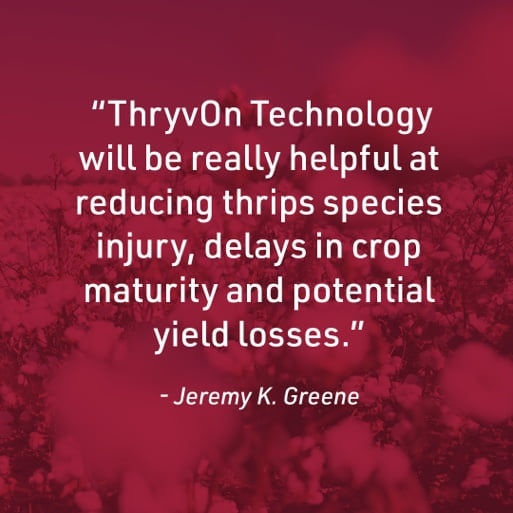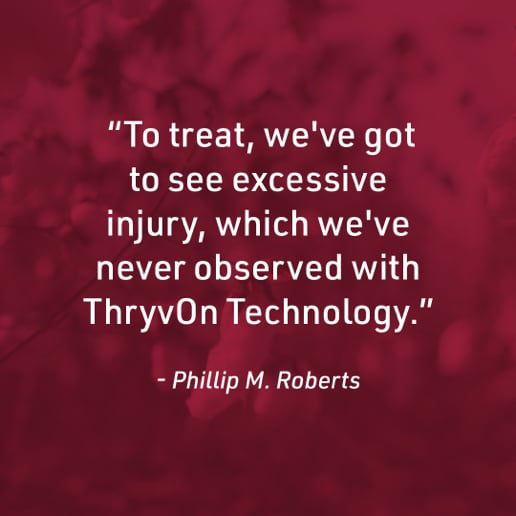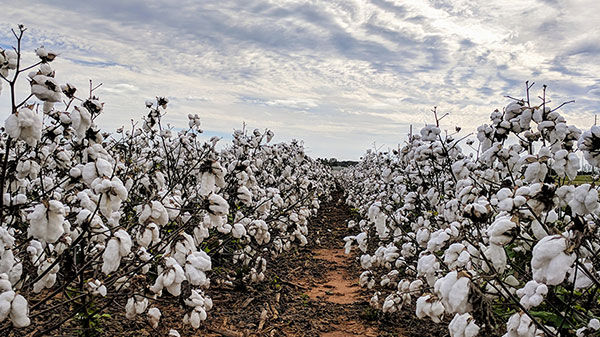6 MIN READ
Expert Q&A: How Thryvon™ Technology Protects Against Pests in the Southeast
July 21, 2023
Cotton growers in the Southeast know their region better than anyone. They also know the Southeast is a unique environment that presents benefits and challenges when it comes to growing cotton, especially in defending against damage from pests like tarnished plant bug and thrips species.
That’s why we talked to three expert entomologists local to the region about their experience with ThryvOn™ Technology. It’s the industry’s first biotech trait to provide built-in protection against key tarnished plant bugs and thrips and may also help reduce the need for some insecticide applications.*
What’s the main benefit of ThryvOn Technology for growers in the southeast?

JEREMY K. GREENE
Clemson University – Professor of Entomology
For South Carolina and much of the Southeast, the main benefit is the protection from thrips species and thrips injury. Thrips are our most consistent early season pest on cotton, but having a solution like ThryvOn Technology will be really helpful at reducing thrips species injury, delays in crop maturity and potential yield losses.
PHILLIP M. ROBERTS
University of Georgia – Professor and Extension Entomologist
Here in Georgia, we’re excited about the new tool and innovation to help protect against tarnished plant bugs and thrips. What it offers in terms of thrips control specifically is really amazing. We have a rather large planting window, and for our earlier planted cotton, we typically see very high thrips pressure. So, ThryvOn Technology is going to be a great tool, especially on those acres for thrips control, because we’ve never seen a situation where you would need to make a supplemental treatment for thrips control when ThryvOn Technology was used. And that’s a pretty bold statement.*
DOMINIC REISIG
North Carolina State University – Professor and Extension Specialist
It’s hard to pick out just one, but for us in North Carolina, the main benefit is being timely with tarnished plant bugs or thrips control. Oftentimes, our seed treatments needed a little help, so we had to use foliar oversprays. But ThryvOn Technology gives us more flexibility with timing because it’s producing a toxin that manages the pests.
What is your tarnished plant bug and/or thrips species action threshold recommendation for ThryvOn Technology?

PHILLIP M. ROBERTS (GA)
Our message to growers is you’re going to have to make a decision to treat based on physical plant injury and not thrips species counts. We’ve got to see excessive injury, which we’ve never observed with ThryvOn Technology, nor have we intervened with a foliar application. We cannot go on thrips species counts — which is an extremely important point — because I’ve seen pretty high populations on cotton with ThryvOn Technology, and the plant injury is minimal.
JEREMY K. GREENE (SC)
ThryvOn Technology is going to change our recommendations a little bit for pests such as thrips, and when I say thrips, I’m referring to tobacco thrips primarily as our species that reproduces on cotton. With ThryvOn Technology, we will focus less on thrips numbers and more on injury to the plant, so the crinkling of leaves and things like that.
DOMINIC REISIG (NC)
Our current threshold is very low for thrips — it’s two larvae per seedling, and nobody uses it because every single field in the state exceeds that threshold. But for ThryvOn Technology, we’re, so far, not recommending any additional insecticides for thrips over the top. Now, we’re not saying that ThryvOn Technology is never going to need a little help, but we just haven’t seen it yet.
What is most exciting to you about ThryvOn Technology?
DOMINIC REISIG (NC)
We did some square removal studies in the Southeast last year, and at one time period, we removed 100% of the squares and didn’t see a yield loss, and the plant was able to put on squares and compensate for that loss with no problem. So, I think ThryvOn Technology will really help us with that sort of nickel-and-dime scenario, to help us be timely with maturing the crop and getting it out of the field.
PHILLIP M. ROBERTS (GA)
If I look at the main benefits, it’s just exciting technology. It does special things to thrips and helps reduce the number of applications, which can help conserve beneficial insects as well.
What are your best management practices in using ThryvOn Cotton?
JEREMY K. GREENE (SC)
ThryvOn Technology can and should be planted in high-risk areas for tarnished plant bugs like in interfacing crop areas where they move out of corn and into cotton. Another great fit is where cotton interfaces with flowering cover crops, which can also host a lot of tarnished plant bugs. It also offers protection from thrips that may be moving from peanuts into cotton.
PHILLIP M. ROBERTS (GA)
When it comes to management, it’s all about ease and saving time. Logistically, it frees up time on the farm and helps utilize labor for getting the crop in and not having to go back and spray for thrips.* So, if you have fields that are hard to get to or keep an eye on, that’s an ideal spot for ThryvOn Technology.
DOMINIC REISIG (NC)
ThryvOn Technology is another great tool in the tool belt that will assist us with reducing sprays throughout the season and hopefully preserve beneficial insects.*
Discover more about how ThryvOn Technology can help growers protect cotton and increase yield.
Explore ThryvOn Technology Solutions
Still have questions? Ask a technical agronomist for advice.
*Scouting is critical to determine which and how many insecticide applications are recommended to avoid economic loss greater than pest management costs (i.e., when economic thresholds are met). Check with your local state extension university for the latest spraying recommendations.

Protection That Powers Performance
ThryvOn™ Technology is the industry's first biotech trait to protect against tarnished plant bug and thrips species that can help you power through performance-robbing threats